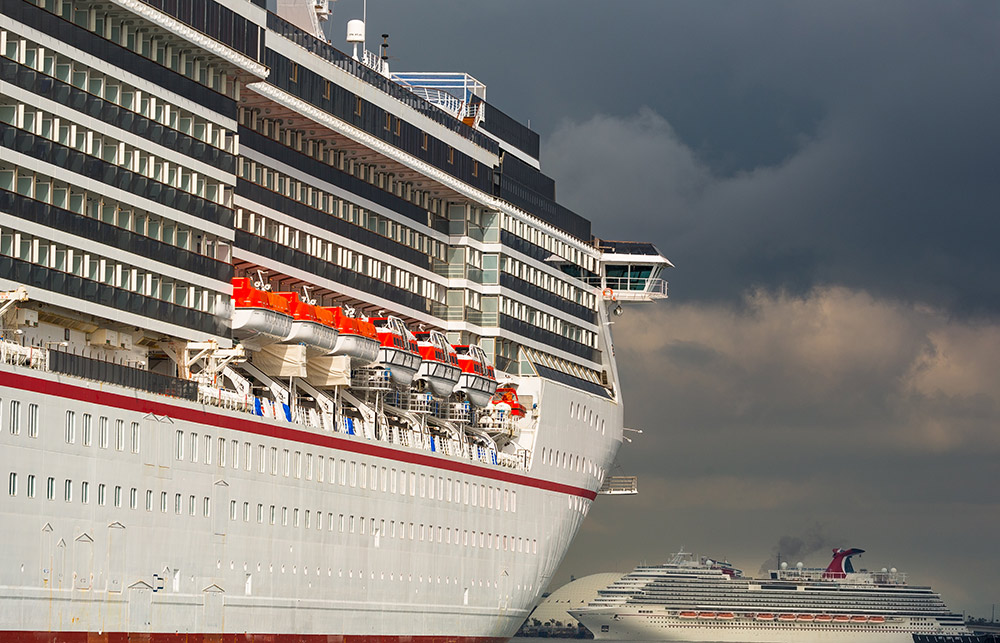
随着邮轮业仍在经受新冠疫情和休闲旅游停摆造成的重创,世界最大的邮轮公司正在流失海量现金。
总部位于巴拿马的嘉年华公司于上周四表示,在截至5月31日的季度中,该公司亏损44亿美元,其中包括因为出售部分邮轮而造成的20亿美元亏损。由于嘉年华几乎所有的业务自3月以来一直陷于停顿,该公司仅录得收入7亿美元,较去年同期的48亿美元暴跌85%。
但痛苦还远未结束。嘉年华表示,尽管该公司计划加快出售更多的巨型漂浮酒店,但在2020年的剩余时间里,其每月平均亏损额预计仍将高达6.5亿美元。据分析师估计,嘉年华此前每个月大约亏损5亿美元。
邮轮公司是最早感受到全球新冠疫情影响的行业之一,并因为应对迟缓而饱受批评。而嘉年华旗下的“至尊公主号”和“钻石公主号”更是成为新冠疫情早期爆发的中心。现在,这家旗下运营品牌包括“公主邮轮”、“荷美邮轮”和同名品牌的业界领头羊正面临乘客诉讼。此外,美国众议院也在调查嘉年华在新冠危机爆发早期的应对举措。
雪上加霜的是,嘉年华及其主要竞争对手均被排除在联邦政府为拯救美国企业而推出的经济刺激计划之外。尽管主要邮轮运营商的总部都设在迈阿密,但从技术上讲,它们皆是海外注册公司。这种长期存在的安排,有助于邮轮公司的大部分利润免缴美国联邦所得税。
嘉年华的首席执行官阿诺德•唐纳德在4月重申了继续在海外注册的意向。但如今,他正在手忙脚乱地寻找其他融资渠道:该公司已经通过债务和股票筹集了66亿美元,用完了33亿美元的周转信贷额度,推迟偿付其他债务,并且正在出售资产。嘉年华在上周四表示,已经就未来90天再出售6艘邮轮达成初步协议,并计划出售更多的邮轮和非邮轮资产。另据该公司透露,截至5月底,它还有76亿美元的可用流动性。
截至2019财年末,嘉年华旗下共有104艘邮轮,另有17艘计划到2025年底全部交付的邮轮订单,其中一些将用来替代现役船舶。(该公司在上周四表示,4艘原计划在10月前建造完成的邮轮预计将推迟交付。)
在游客能够重新登船之前,这些措施或许有助于嘉年华维持生计,尽管现在越来越不清楚那将是什么时候。嘉年华此前宣布有望在8月1日复航,但唐纳德最近不再抱有这种希望。
他上周接受旅游网站The Points Guy采访时表示:“我希望给你一个具体日期,但我们做不到,因为这本质上是一个监管问题。”
美国疾控中心在4月将邮轮“禁航令”延长到至少7月24日。但业内人士认为监管当局很可能会进一步推迟复航时间。挪威邮轮控股公司在上周表示,10月前不会恢复邮轮运营。
在上周四的财报电话会议上,嘉年华并没有明确回应此前所做的8月1日复航预测,只是表示该公司“无法确切预测何时恢复正常运营。”
与此同时,嘉年华旗下邮轮也并非完全没有乘客,无论他们多么不情愿。新冠疫情导致的停航,致使8万多名员工滞留在大海上,直到他们可以被遣返回国。
所有邮轮公司的员工都报告称,被困在海上邮轮的日子非常不好过,有些人还感染了新冠病毒。据《迈阿密先驱报》报道,截至5月中旬,有超过578名船员在海上感染了新冠肺炎,其中7人死亡;据说还有人自杀身亡。
嘉年华在上周四宣称,已经通过船舶或包机等方式将大约6万名邮轮员工遣返回130多个国家。另有2.1万名员工将在6月底前被遣返回国。嘉年华补充说,公司正在“密切关注这些长期滞留在船上的员工的身心健康。”
该公司采取的措施包括让员工接触到“新鲜空气,并进入船上的其他区域,”并为他们提供电影、互联网和心理咨询服务。嘉年华“还为大多数船员提供了单人舱住宿,其中许多舱位都配有一扇窗户或阳台。”(财富中文网)
译者:任文科
随着邮轮业仍在经受新冠疫情和休闲旅游停摆造成的重创,世界最大的邮轮公司正在流失海量现金。
总部位于巴拿马的嘉年华公司于上周四表示,在截至5月31日的季度中,该公司亏损44亿美元,其中包括因为出售部分邮轮而造成的20亿美元亏损。由于嘉年华几乎所有的业务自3月以来一直陷于停顿,该公司仅录得收入7亿美元,较去年同期的48亿美元暴跌85%。
但痛苦还远未结束。嘉年华表示,尽管该公司计划加快出售更多的巨型漂浮酒店,但在2020年的剩余时间里,其每月平均亏损额预计仍将高达6.5亿美元。据分析师估计,嘉年华此前每个月大约亏损5亿美元。
邮轮公司是最早感受到全球新冠疫情影响的行业之一,并因为应对迟缓而饱受批评。而嘉年华旗下的“至尊公主号”和“钻石公主号”更是成为新冠疫情早期爆发的中心。现在,这家旗下运营品牌包括“公主邮轮”、“荷美邮轮”和同名品牌的业界领头羊正面临乘客诉讼。此外,美国众议院也在调查嘉年华在新冠危机爆发早期的应对举措。
雪上加霜的是,嘉年华及其主要竞争对手均被排除在联邦政府为拯救美国企业而推出的经济刺激计划之外。尽管主要邮轮运营商的总部都设在迈阿密,但从技术上讲,它们皆是海外注册公司。这种长期存在的安排,有助于邮轮公司的大部分利润免缴美国联邦所得税。
嘉年华的首席执行官阿诺德•唐纳德在4月重申了继续在海外注册的意向。但如今,他正在手忙脚乱地寻找其他融资渠道:该公司已经通过债务和股票筹集了66亿美元,用完了33亿美元的周转信贷额度,推迟偿付其他债务,并且正在出售资产。嘉年华在上周四表示,已经就未来90天再出售6艘邮轮达成初步协议,并计划出售更多的邮轮和非邮轮资产。另据该公司透露,截至5月底,它还有76亿美元的可用流动性。
截至2019财年末,嘉年华旗下共有104艘邮轮,另有17艘计划到2025年底全部交付的邮轮订单,其中一些将用来替代现役船舶。(该公司在上周四表示,4艘原计划在10月前建造完成的邮轮预计将推迟交付。)
在游客能够重新登船之前,这些措施或许有助于嘉年华维持生计,尽管现在越来越不清楚那将是什么时候。嘉年华此前宣布有望在8月1日复航,但唐纳德最近不再抱有这种希望。
他上周接受旅游网站The Points Guy采访时表示:“我希望给你一个具体日期,但我们做不到,因为这本质上是一个监管问题。”
美国疾控中心在4月将邮轮“禁航令”延长到至少7月24日。但业内人士认为监管当局很可能会进一步推迟复航时间。挪威邮轮控股公司在上周表示,10月前不会恢复邮轮运营。
在上周四的财报电话会议上,嘉年华并没有明确回应此前所做的8月1日复航预测,只是表示该公司“无法确切预测何时恢复正常运营。”
与此同时,嘉年华旗下邮轮也并非完全没有乘客,无论他们多么不情愿。新冠疫情导致的停航,致使8万多名员工滞留在大海上,直到他们可以被遣返回国。
所有邮轮公司的员工都报告称,被困在海上邮轮的日子非常不好过,有些人还感染了新冠病毒。据《迈阿密先驱报》报道,截至5月中旬,有超过578名船员在海上感染了新冠肺炎,其中7人死亡;据说还有人自杀身亡。
嘉年华在上周四宣称,已经通过船舶或包机等方式将大约6万名邮轮员工遣返回130多个国家。另有2.1万名员工将在6月底前被遣返回国。嘉年华补充说,公司正在“密切关注这些长期滞留在船上的员工的身心健康。”
该公司采取的措施包括让员工接触到“新鲜空气,并进入船上的其他区域,”并为他们提供电影、互联网和心理咨询服务。嘉年华“还为大多数船员提供了单人舱住宿,其中许多舱位都配有一扇窗户或阳台。”(财富中文网)
译者:任文科
As the pandemic and its near-total shutdown of leisure travel continues to ravage the cruise industry, the world’s largest cruise company is leaking floods of cash.
Carnival Corp. lost $4.4 billion in the quarter ended May 31, including a $2 billion loss from selling off some of its cruise ships, the Panama-based company said last Thursday. With almost all of its operations on hold since March, the company eked out $700 million in revenue—an 85% plummet from $4.8 billion a year earlier.
But the pain is far from over: Even as the company plans to accelerate the sales of more of its enormous floating hotels, Carnival says it expects to burn an average of $650 million per month for the rest of 2020. It previously was burning about $500 million every month, according to analyst estimates.
Cruise companies were some of the earliest businesses to feel the effects of the global COVID-19 pandemic—and to draw widespread criticism for their lumbering response to it. Carnival, which operates Princess Cruises as well as Holland America and its eponymous brand, was at the center of early COVID-19 outbreaks on its Grand Princess and Diamond Princess ships. Now the company is facing passenger lawsuits and a U.S. House of Representatives probe into its handling of the early crisis.
Compounding their financial pain, Carnival and its top competitors were also left out of the U.S. federal stimulus package designed to throw American businesses a lifeline. While the major cruise operators all have headquarters in Miami, they are technically incorporated overseas, in a long-standing arrangement that allows them to avoid paying U.S. federal income tax on most of their profits.
Carnival CEO Arnold Donald in April reaffirmed his company’s intention to remain incorporated abroad. But now he is scrambling for other financing: His company has raised $6.6 billion in debt and stock, completely tapped its $3 billion revolving credit facility, deferred other debt payments, and is selling off assets. Carnival said last Thursday that it has preliminary agreements to sell another six ships in the next 90 days, and is working to sell more ships and non-ship assets. The company says it had $7.6 billion of available liquidity by the end of May.
Carnival had 104 ships in its fleet at the end of its 2019 fiscal year, with 17 additional ships, including planned replacements for existing vessels, on order through 2025. (The company said last Thursday that it expects delays in the delivery of four of those ships, which previously had been scheduled to be constructed before October.)
Those measures may help Carnival stay afloat until passengers are able to reboard its ships—although it has become increasingly unclear when that will be. While the company had previously said it might resume some cruises on Aug. 1, Donald has backed away from that hope in recent days.
“I wish I could give you a date, but we can’t, because it’s a regulatory matter,” Donald told travel website The Points Guy in an interview last week.
The U.S. Centers for Disease Control and Prevention in April extended a “no-sail” order for cruise ships through at least July 24. But industry members seem to anticipate further regulatory delays; last week, Norwegian Cruise Line Holdings said it would not resume cruise operations before October.
On last Thursday, Carnival did not specifically address its previous Aug. 1 prediction, but said it “is unable to definitively predict when it will return to normal operations.”
In the meantime, Carnival ships aren’t entirely without passengers, however unwilling they may be. The pandemic-related shutdown of cruising stranded more than 80,000 Carnival employees at sea, on board ships, until they could be repatriated to their home countries.
Employees across all cruise companies have reported grim and sometimes COVID-infected conditions while they have been trapped at sea. By mid-May, more than 578 crew members had contracted COVID-19 at sea, and seven had died, the Miami Herald reported; others have reportedly died by suicide.
On last Thursday, Carnival said it had repatriated approximately 60,000 cruise-ship employees to more than 130 countries, either by sailing them home or by chartering flights. Another 21,000 employees will be repatriated by the end of June, according to Carnival, which added that it is “focusing on the physical and mental health” of employees “experiencing extended stays on board.”
That includes giving employees access to “fresh air and other areas of the ship,” as well as movies, Internet, and counseling services. The company also said it is “providing most shipboard team members with single occupancy cabin accommodations, many with a window or balcony.”






